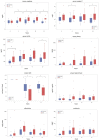Novel Biomarkers for Early Detection of Acute Kidney Injury and Prediction of Long-Term Kidney Function Decline after Partial Nephrectomy
- PMID: 37189664
- PMCID: PMC10135876
- DOI: 10.3390/biomedicines11041046
Novel Biomarkers for Early Detection of Acute Kidney Injury and Prediction of Long-Term Kidney Function Decline after Partial Nephrectomy
Abstract
Background: Identifying acute kidney injury (AKI) within few hours of onset is certainly helpful. However, early prediction of a long-term eGFR decline may be an even more important goal. Our aim was to identify and compare serum [creatinine, kineticGFR, cystatin C, neutrophil gelatinase-associated lipocalin (NGAL)] and urinary (NephroCheck, NGAL, proteinuria, albuminuria, acantocytes at urinary sediment) predictors of AKI that might efficiently predict long-term GFR decline after robotic Nephron-Spearing Surgery (rNSS).
Methods: Monocentric prospective observational study. Patients scheduled for rNSS for suspected localized Renal Cell Carcinoma from May 2017 to October 2017 were enrolled. Samples were collected preoperatively and postoperatively (timepoints: 4 h, 10 h, 24 h, 48 h), while kidney function was re-assessed up to 24 months.
Results: 38 patients were included; 16 (42%) developed clinical AKI. The eGFR decline at 24 months was more pronounced after postoperative AKI (-20.75 vs. -7.20, p < 0.0001). KineticGFR at 4 h (p = 0.008) and NephroCheck at 10 h (p = 0.001) were, at multivariable linear regression analysis, efficient predictors of post-operative AKI and long-term eGFR decline if compared to creatinine (R2 0.33 vs. 0.04).
Conclusions: NephroCheck and kineticGFR have emerged as promising noninvasive, accurate, and early biomarkers of postoperative AKI and long-term GFR decline after rNSS. Combining NephroCheck and kineticGFR in clinical practice would allow to identify high risk of postoperative AKI and long-term GFR decline as early as 10 h after surgery.
Keywords: IGFBP7; NGAL; NephroCheck; TIMP-2; acute kidney injury; biomarkers; partial nephrectomy; renal cell carcinoma.
Conflict of interest statement
The authors declare no conflict of interest.
Figures



References
-
- Antonelli A., Minervini A., Sandri M., Bertini R., Bertolo R., Carini M., Furlan M., Larcher A., Mantica G., Mari A., et al. Below Safety Limits, Every Unit of Glomerular Filtration Rate Counts: Assessing the Relationship Between Renal Function and Cancer-specific Mortality in Renal Cell Carcinoma. Eur. Urol. 2018;74:661–667. doi: 10.1016/j.eururo.2018.07.029. - DOI - PubMed
LinkOut - more resources
Full Text Sources
Research Materials
Miscellaneous

